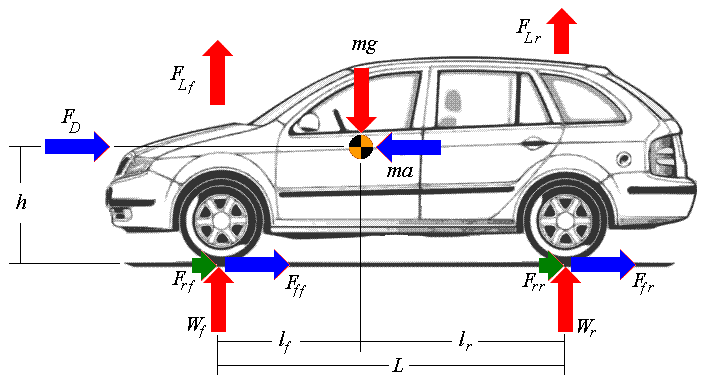
From the previous figure (and assuming four identical tires), we can define the total friction force (Ff), the total rolling resistance (Fr) and the net vertical force (Fv):
| Fv = mg − FLf − FLr = mg − FL = |
( |
1 − |
|
) |
mg = |
( |
1 − |
|
) |
mg |
|
Since practically all vehicles brake with both front and rear axles, the maximum force coming from the brake system will be the friction force from all tires (Ff).
Also, if we sum up the forces in the horizontal direction:
Stopping distance
From equation (1a) we get:(more)
| a = |
( |
μ + fr |
) |
g + |
|
[ |
CDA − |
( |
μ + fr |
) |
CLA |
] |
v2 |
|
(1b) |
This defines the maximum possible deceleration of the vehicle at any given speed v. To simplify future notations, we will write equation (1b) the following way: a = Kt + Kav2.
Solving the equations of motion, we can find the stopping distance d necessary for decelerating from speed v to 0 with equation (2):
(more)
Where:
|
|
| Ka = |
|
[ |
CDA − |
( |
μ + fr |
) |
CLA |
] |
|
And:
This is the equation that is used to estimate the tire friction coefficient μ with a given stopping distance d in equation (2) of the TIRE COEFFICIENT section. Equation (2) was rewritten to isolate μ assuming CLA = 0.
Axle load distribution
When braking, there will be a weight transfer from the rear axle to the front axle. It will be important to know the exact amount when we will design our brake system such that we can distribute adequately the brake force between the front and the rear axle, because the maximum brake forces at each axle will be:
(more)
we can find the portion of the vertical force on the rear axle:
To find the portion of the vertical force on the front axle: (more)
Where:
The first component of equation (3b), lr/L, is the portion of the vehicle's weight on the front axle (at rest) and the other component of equation (3b) is the weight transferred from the rear axle to the front axle.
Note also that the portion of the vertical force on the front axle cannot exceed 100%. At this point, the vehicle is doing a «stoppie» as shown in the next figure.


